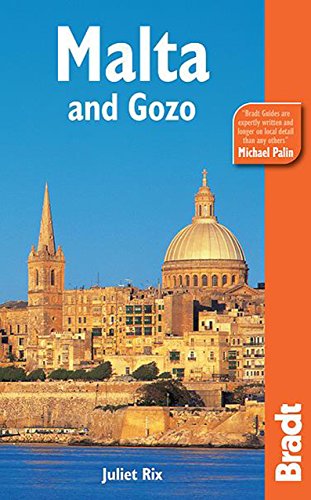
With some 300 days of sunshine a year, Malta has long been known for package holidays. But anyone going to Malta merely to lie in the sun is seriously missing out. Packed into this island nation are 7,000 years of fascinating – and visible – history, and the Bradt guide delves into Malta’s temples and archaeology more comprehensively than any other guidebook. Also covering birdwatching, summer festas, the less commercialized islands of Gozo and Comino, and highlighting accommodation and restaurants of interest and character rather than just looking at convenience and budget, this guidebook discovers the Malta beyond the tourist resorts.
'Bang up to date and easy to follow. ... full of fascinating asides.' Journal of the International Map Collectors' Society - Spring 2011
Juliet Rix has been a journalist for 25 years, and has worked for the BBC (television and radio), magazines, the internet and British national newspapers.
Most helpful customer reviews
8 of 10 people found the following review helpful.![]() POMSKIZILLIOUS AND GROMPHIBEROUS
POMSKIZILLIOUS AND GROMPHIBEROUS
By DAVID BRYSON
300 pages of small print (although including several pages of colour photographs) might seem a lot for a guide to such a diminutive country as Malta. Not really: not when the country is home to some of the oldest surviving buildings and artefacts in the entire world. They go back to the 6th millennium B C, but of course they are `silent witnesses'. The Maltese antiquities greatly predate Mycenae Tiryns and Cnossos, but if anything was written by their creators none of the writing has survived. We have no equivalent of the Linear B tablets, let alone any such bardic tradition as has come down to us under the name of Homer.
As tourist guides go, this one is decidedly upmarket. The stuff we would normally expect is here of course, like ratings for hotels and restaurants, information on travel and transport, and the best locations to find sea, sun, sand and whatever else. If night-spots get proportionately less coverage than they do in most guide-books, that must be because, according to the author, Malta largely closes down around 9 p.m. (as does eastern Berlin, or it did when I was there 5 or 6 years ago). There is also the sort of general commentary on the look, feel and atmosphere of the place and its culture that ought to be here, and politically correct inclusiveness is dutifully represented by a brief paragraph on the gay scene. What is different about this guide is the amount of space that is devoted to `places of interest'.
That kind of material can be desperately laboured and boring in other guides to other places, but anyone who is bored by the history and pre-history of Malta is really missing something. There is a fascinating summarised account of it all, 5000 B C to 2010 A D, and Juliet Rix is obviously enthralled by it, as well she might be. By `Malta' of course I mean the whole country by that name, comprising the eponymous main island plus its smaller northern neighbour Gozo and the mini-island Comino lying just south of Gozo. Malta has the highest population density of any European country, but mainly on the larger island. Gozo is quieter, it is Gozo that I know better from my one visit with my family in 1985, the little Gozitan village of Xlendi in its miniature canyon leading down to the sea is where we were based for two weeks, and Xlendi is the very last place mentioned in the book. Throughout the last millennium Gozo was as prone as Malta itself to attacks by Turks, Arabs and Napoleon, but during WWII, when Malta was being intensively bombarded, Gozo was left largely unscathed by the Axis. Edward Lear (he of the limericks) was entranced by Gozo, so was I, and it is still what he called it `pomskizillious and gromphiberous'.
Where the larger island scores is simply, I suppose, in being larger. The Grand Harbour is awesome, the antiquities are more numerous, and the seaward fortifications are unique and colossal. See those and then see whether you don't want to know more about the history behind them. There are more fascinating sites per acre on Malta, I guess, than anywhere else in the world, and this guide has been compiled by an author with a genuine interest in them. When they start to get a bit much for you, then that is perhaps the time to retreat to Gozo, and you will start off with a very favourable impression after sailing out of the rather ugly and functional harbour of Cirkewwa and being welcomed to Gozo by the beautiful sight of Mgarr. Comino I know only from swimming in the Blue Lagoon, but that experience converted even a dry-land sportsman like me to swimming for the time being, and Gozo harbours, inter alia, the cave where the nymph Calypso supposedly detained Odysseus for several years, not that he minded.
Perhaps I am beginning to explain how such a small place requires a long guide. There was far more there than I could get my feet around, let alone get my head around, in two weeks. Considered just as a selling job, something that makes me itch to go back and stay longer, this approach has done the trick for me.
3 of 4 people found the following review helpful.![]() Trip Preparation
Trip Preparation
By Joe Higgins
Guide very thorough and informative. A must in my opinion for Malta vacationers regardless of island familiarity. A good universal, detailed discription of Malta history, accommodations, restaurants and year-round activities for the short or long-term visitor! If you are not planning a trip to Malta, this guide will make you want to visit!
0 of 0 people found the following review helpful.![]() Five Stars
Five Stars
By Dan Matz
Detailed and informative guide.

No comments:
Post a Comment